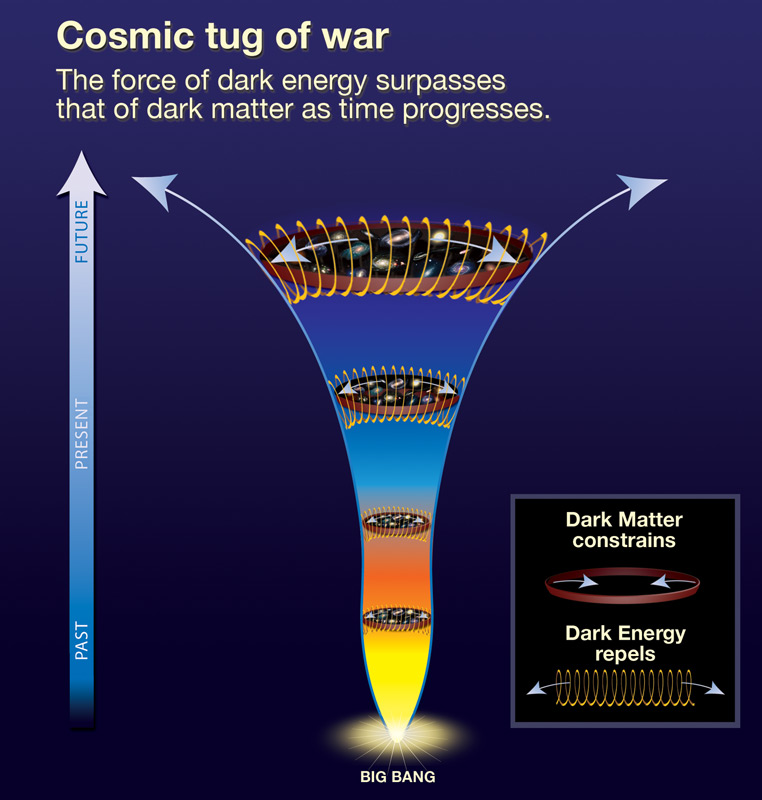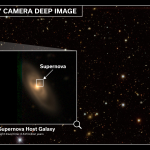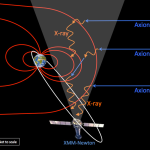Dark energy remains one of the most enigmatic forces shaping our universe, responsible for its accelerating expansion. Recent findings from the international Dark Energy Spectroscopic Instrument (DESI) collaboration, which includes esteemed researchers from Harvard, suggest that this mysterious energy, often equated with a ‘cosmological constant,’ may not be as constant as previously believed. This revelation sparks critical discussions about the balance between dark energy and matter, a relationship that dictates the ultimate fate of the cosmos. By analyzing over 14 million galaxies and quasars, DESI sheds light on dark energy’s evolving effects over the past 11 billion years, challenging established theories and inspiring new astrophysical research. As scientists continue to unravel the complexities of dark energy, our understanding of the universe’s destiny becomes increasingly profound.
Known in some circles as the mysterious force propelling the universe’s rapid expansion, dark energy has become a focal point of modern astrophysics. This cosmic enigma, often linked to the concept of the cosmological constant, invites scientists to probe into its potential weaknesses and influences on the structure of the universe. The ongoing investigations led by the DESI collaboration, integral to understanding the interplay between dark energy and its counterpart, dark matter, are revealing crucial insights into the cosmos’s growth and evolution. With a collaborative spirit, astrophysicists are delving deeper into the 3D map of our universe, examining how the subtle effects of dark energy shape cosmic phenomena. As research progresses, the implications for cosmological models and future explorations become ever more significant.
The Role of Dark Energy in Universe Expansion
Dark energy plays a pivotal role in our understanding of the universe’s accelerated expansion. Initially theorized as a cosmological constant, recent findings from the DESI collaboration suggest that this mysterious force may be evolving, which could alter our fundamental comprehension of cosmology. This insight mandates a reassessment of existing astrophysical models, specifically regarding how matter and dark energy interact, shaping the cosmos as we know it.
The implications of changing dark energy dynamics are profound. Not only do they influence the rate of the universe’s expansion, but they also affect the distribution of matter across vast cosmic distances. The DESI research contributes significantly to this understanding by providing a more detailed mapping of galaxies and quasars over 11 billion years, revealing trends and effects that were previously undetectable. As we delve deeper into these dark energy effects, our grasp of the universe’s fate could shift dramatically.
How the DESI Collaboration Enhances Cosmological Research
The Dark Energy Spectroscopic Instrument (DESI) collaboration represents one of the most ambitious efforts in modern astrophysical research. With over 900 scientists from more than 70 institutions, it catalyzes significant advancements in our cosmological knowledge. Each team member contributes unique expertise, such as developing algorithms to interpret complex data sets, which is crucial for analyzing the vast amounts of information collected from over 14 million celestial objects.
The contributions of researchers at the Center for Astrophysics | Harvard & Smithsonian underline the multifaceted nature of this collaboration. By merging findings from DESI with other astronomical experiments, scientists deepen their understanding of cosmic evolution, dark matter effects, and galactic structures. The shared findings, now accessible in public databases, not only foster collaboration but also encourage independent studies across the globe, enriching the broader community engaged in astrophysical research.
Insights from 11 Billion Years of Cosmological Data
The recently developed 3D map of the universe represents a monumental achievement in cosmology, providing insights derived from 11 billion years of cosmic history. By leveraging Baryon Acoustic Oscillations as a standard ruler, researchers assess dark energy’s influence over time, elucidating how its strength has potentially changed. This method allows for a clearer understanding of cosmic expansion and the underlying mechanics driving these universal changes.
Moreover, the findings from DESI signify a turning point in our cosmic narrative. As scientists analyze patterns within the galaxy distributions further, they can collaborate on incorporating these insights into existing models of the universe’s expansion. This ongoing research emphasizes the necessity for continuous engagement with new data to refine our understanding of dark energy and its effects on the cosmos.
Exploring Dark Matter and Its Interactions with Dark Energy
Dark matter, while elusive, is essential in our cosmological framework. Together with dark energy, it accounts for most of the universe’s mass-energy content. Understanding how dark matter interacts with dark energy is crucial for comprehending the universe’s overall dynamics. Current research from the DESI collaboration aims to clarify these interactions and provide insights into how dark matter’s effects are manifested across various cosmic structures.
As the DESI survey progresses, the combined data from multiple celestial observations could reveal unknown relationships between dark energy and dark matter. Delving into these associations not only advances our understanding but could also lead to revolutionary insights about the universe. This holistic approach to astrophysical research encourages us to rethink long-held theories and embrace a future where the cosmos remains a subject of endless exploration.
The Importance of Astrophysical Research in Modern Astronomy
Astrophysical research has always served as a foundation for our understanding of the universe. The collaboration of institutions like the DESI team exemplifies the collaborative spirit necessary for advancing knowledge in such a complex field. Through shared resources, pooling expertise, and a relentless pursuit of data, researchers across the globe have been able to expand our understanding of cosmic phenomena at unprecedented scales.
Furthermore, as public interest in astronomy grows, the accessibility of findings—like those released from the latest Data Release 1—promotes engagement with astrophysical research beyond academic circles. This transparency allows enthusiasts and emerging scientists alike to explore vast datasets, cultivate ideas, and contribute to ongoing conversations about the universe’s evolution and the role of dark energy and matter within it.
Baryon Acoustic Oscillations: A Key to Understanding Expansion
Baryon Acoustic Oscillations serve as an essential tool in astrophysics for measuring cosmic expansion, acting like a cosmic ruler that reveals patterns in the distribution of galaxies over time. This method has been fundamental to the research efforts of the DESI collaboration, allowing scientists to map how structures in the universe have developed in alignment with the universe’s expansion rate, influenced by dark energy.
By scrutinizing these oscillations across different epochs, researchers can gain insights into the changing dynamics of dark energy compared to familiar entities like dark matter. Understanding these patterns will augment existing cosmological models, potentially leading to discoveries that challenge current paradigms about how the universe has evolved over billions of years.
New Frontiers in Data-Driven Cosmic Exploration
The advancements made possible by the DESI collaboration signal new frontiers in cosmic exploration driven by rich data sets. With innovative techniques for analyzing vast amounts of galactic data, astrophysicists can uncover patterns and relationships that were once beyond reach. This ongoing endeavor not only aids in mapping the universe but also helps fine-tune our comprehension of cosmic expansion and the intricate dance between dark energy and dark matter.
As researchers continue to analyze this immense influx of information, they can tackle fundamental questions regarding the universe’s fate. Each discovery made through such explorations not only enriches our current understanding but also fuels curiosity, inspiring new lines of inquiry that could one day redefine our cosmological paradigm.
The DESI Data Release: Fueling Future Discoveries
The recent release of DESI Data Release 1 represents a significant step forward in astrophysical research, offering rich, detailed information that spans millions of celestial objects. This data not only enhances our ability to study dark energy and the universe’s structure but also provides a resource for researchers and enthusiasts alike to engage with the data and develop new insights into cosmic phenomena.
With this open access to detailed and expansive datasets, the collaboration encourages the global community to participate actively in decoding the mysteries of the universe. By fostering collaboration through shared information, researchers can converge on new hypotheses, leading to a deeper understanding of the cosmos and its driving forces, including the dynamic nature of dark energy.
The Future of Cosmology: Revisiting Fundamental Assumptions
As findings from the DESI collaboration illustrate the potential evolution of dark energy, the field of cosmology stands on the brink of potential transformation. These evolving insights prompt researchers to revisit long-established assumptions about the universe’s expansion and the forces at play. Such a critical examination of foundational concepts may lead to significant advances in theoretical physics and our understanding of fundamental cosmological principles.
The ongoing discourse surrounding dark energy, particularly as it may not remain constant, suggests a future where the scientific community must remain adaptable. Embracing this uncertainty can be an asset, offering opportunities for new research avenues that can illuminate the intricate mechanisms governing the universe. As we advance in exploration, it becomes essential to maintain an inquisitive spirit, nurturing ideas that challenge the status quo.
Frequently Asked Questions
What is dark energy and how does it relate to the expansion of the universe?
Dark energy is a mysterious force that is believed to be driving the accelerated expansion of the universe. It acts as a repulsive energy, counteracting the gravitational effects of dark matter and ordinary matter. This phenomenon is crucial to our understanding of the universe’s fate and is often associated with the cosmological constant in Einstein’s field equations.
How has the DESI collaboration contributed to our understanding of dark energy?
The Dark Energy Spectroscopic Instrument (DESI) collaboration has significantly advanced our understanding of dark energy by creating the largest 3D map of the universe. By analyzing data from millions of galaxies, DESI helps track how dark energy influences the distribution of matter across cosmic time, providing insights into its potential variations over the last 11 billion years.
What implications does the weakening of dark energy have for the future of the universe?
Recent findings from the DESI collaboration suggest that dark energy may be weakening over time, which could challenge current models of cosmology. If dark energy continues to change, it may alter the predicted fate of the universe, potentially leading to a different cosmic evolution than previously anticipated, raising critical questions in astrophysical research.
How do Baryon Acoustic Oscillations help us measure dark energy’s effects?
Baryon Acoustic Oscillations (BAO) are patterns from early cosmic events that serve as a cosmic ruler. By measuring these oscillations at different distances and times, researchers can evaluate the expansion rate of the universe. This provides a method to track the influence of dark energy throughout history, revealing how it has affected cosmic growth over billions of years.
What role does dark matter play in the study of dark energy?
Dark matter interacts through gravity and significantly affects the structure and evolution of the universe. Understanding dark matter’s effects is essential for studying dark energy, as both are critical components of the universe’s makeup. The interplay between dark matter and dark energy influences the overall dynamics of cosmic expansion, as showcased in DESI’s research.
What future research can be expected from the DESI collaboration regarding dark energy?
The DESI collaboration is poised to continue its detailed exploration of dark energy by collecting and analyzing data every clear night. Future studies will focus on expanding the 3D cosmic map and investigating the properties and potential evolution of dark energy, alongside its interactions with dark matter and the overall structure of the universe.
How can the public access the findings from the DESI collaboration regarding dark energy?
The DESI collaboration has made its findings publicly accessible through Data Release 1, which contains extensive datasets related to millions of celestial objects. This data is available for exploration on platforms like arXiv, allowing both the public and researchers to engage with the latest advancements in astrophysics and dark energy research.
| Key Points | Details |
|---|---|
| Collaboration and Research | The international Dark Energy Spectroscopic Instrument (DESI) project involves over 900 researchers from 70 institutions, including Harvard, focusing on dark energy and its effects. |
| Significance of Dark Energy | Dark energy is thought to influence the universe’s accelerating expansion, posing questions about its potential weakening over time. |
| Methodology | DESI employs the largest 3D cosmic map, analyzing data from over 14 million galaxies and quasars to measure dark energy’s evolution. |
| Historical Analysis | The research examines dark energy’s impact over 11 billion years, utilizing Baryon Acoustic Oscillations as a cosmic measurement tool. |
| Results and Findings | New findings suggest dark energy’s effects may be evolving, leading to potential reevaluation of the standard cosmological model. |
| Future Directions | The collaboration continues to explore various astrophysical topics and plans public data releases to enhance research capabilities. |
Summary
Dark energy remains a fundamental aspect of understanding the universe. The recent findings from the DESI collaboration suggest that dark energy could be weakening over time, raising significant questions about the universe’s future and challenging existing cosmological models. With ongoing research and data collection, scientists are better equipped to explore dark energy’s role, potentially reshaping our understanding of cosmic evolution.








